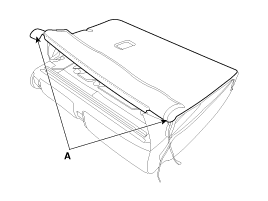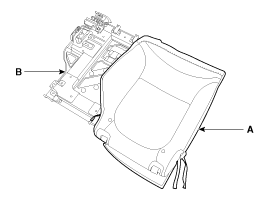Kia Soul EV: Rear Seat / Rear Seat Back Cover Repair procedures
Kia Soul EV (PS EV) 2015-2020 Service Manual / Body (Interior and Exterior) / Rear Seat / Rear Seat Back Cover Repair procedures
| Replacement |
| [LH] |
|
|
| 1. |
Remove the rear seat back assembly [LH].
(Refer to Rear Seat - "Rear Seat Assembly") |
| 2. |
Push the lock pin (B), remove the rear seat headrest (A).
|
| 3. |
Using a screwdriver or remover, remove the rear seat folding bezel (A).
|
| 4. |
Using a screwdriver or remover, remove the rear seat belt center cover (A).
|
| 5. |
Using a screwdriver or remover, remove the tether anchor garnish (A).
|
| 6. |
Using a screwdriver or remover, remove the rear seat back bush hinge (A).
|
| 7. |
Remove the protector (A) located in the bottom side of the rear seat back.
|
| 8. |
Zip off the rear seat back cover located in the side (A), and then pull it up.
|
| 9. |
Pull out the hooks (A) by the rear seat back frame.
|
| 10. |
Turn the rear seat back cover inside out. Then pull out the
headrest guides (A) while pinching both sides of the lower part of the
guides, and remove them.
|
| 11. |
Remove the rear seat back cover (A) from the rear seat back frame (B).
|
| 12. |
Remove the hog-ring clip (A) velcro tape (B) on the rear of seat back and then remove the rear seat back cover (C).
|
| 13. |
Install in the reverse order of removal.
|
| [RH] |
|
|
| 1. |
Remove the rear seat back assembly [RH].
(Refer to Rear Seat - "Rear Seat Assembly") |
| 2. |
Push the lock pin (B), remove the rear seat headrest (A).
|
| 3. |
Using a screwdriver or remover, remove the rear seat folding bezel (A).
|
| 4. |
Using a screwdriver or remover, remove the tether anchor garnish (A).
|
| 5. |
Using a screwdriver or remover, remove the rear seat back bush hinge (A).
|
| 6. |
Remove the protector (A) located in the bottom side of the rear seat back.
|
| 7. |
Zip off the rear seat back cover located in the side (A), and then pull it up.
|
| 8. |
Pull out the hook (A) by the rear seat back frame.
|
| 9. |
Turn the rear seat back cover inside out. Then pull out the
headrest guides (A) while pinching both sides of the lower part of the
guides, and remove them.
|
| 10. |
Remove the rear seat back cover (A) from the rear seat back frame (B).
|
| 11. |
Removing the hog-ring clips (A), Velcro tape (B) on the rear of seat back and then remove the seat back cover (C).
|
| 12. |
Install in the reverse order of removal.
|
 Rear Seat Back Cover Components and Components Location
Rear Seat Back Cover Components and Components Location
Component Location
1. Rear seat back cover [LH]2. Rear seat back cover [RH]
...
 Rear Seat Cushion Cover Components and Components Location
Rear Seat Cushion Cover Components and Components Location
Component Location
1. Rear seat cushion cover
...
Other information:
Kia Soul EV (PS EV) 2015-2020 Service Manual: Special Service Tools
Special Service Tools Tool Name / NumberIllustrationDescriptionBand installer09495-3K000Used to install ear type boot bandPuller09495-33000Used to remove spider assemblyBall joint puller09568-34000Used to separate ball joint from the front axle. ...
Kia Soul EV (PS EV) 2015-2020 Service Manual: A/C Pressure Transducer Components and Components Location
Component Location [Without Heat Pump] 1. A/C pressure transducer [With Heat Pump] 1. A/C pressure transducer ...
Copyright © www.ksoulev.com 2020-2025


























